In the Moment: Sweet lord, it’s the Rollie Free shot
Welcome to a new weekly feature we’re calling In the Moment!
This all started in Slack, the messaging software we use for staff communication. Several weeks ago, Hagerty’s editor-at-large, Sam Smith, began kicking off our mornings by plopping a random archive photo into our chat room.
In addition to being a lifelong student of automotive history, Smith drinks a lot of coffee. Each photo he dropped into the conversation was accompanied by a bit of caffeine-fueled explanation.
We liked these drops a lot, so we’re sharing one here each Thursday. Enjoy, and let us know what you think in the comments! —Ed.
**
Bonneville is one of those places you do not forget. The salt is so wide and white and uniform that depth perception goes momentarily hinky. If the flats have not been flooded by recent rain, they will look like snow. The surface is hard and crusty when dry, a spreadable paste when moist, and a Dead Sea soup when in flood.
People have used it for engine-powered record-breaking for almost as long as we have had engines and records.
In the Moment usually lingers on one image, but the shot at the top of this post is unique. It carries story but lacks detail. Let’s briefly switch to another photo.

The man in dark clothes is the same one from up top: Roland “Rollie” Free. In 1950, when this picture was taken, he was 49 years old. He is at Bonneville, in front of a Vincent Black Lightning, the same model of motorcycle he is riding in the top image. It is a two-cylinder, chain-driven, girder-fork, 70-hp English device. The moment captured by this photo was not the first time Free had taken a Vincent to the salt.
Four decades later, an Englishman named Richard Thompson wrote a piece of music. Sharing that music while discussing Vincents is stout cliché, but to hell with it, life is short, we don’t cover Vincents often. Plus, it’s a good song.
I suspect Thompson could look at Vincents forever. So could I. This Vincent, double forever. Note the Mobil “pegasus” on the tank. Note, also, how there is no seat or front brake. The cylinder between rear fender and fuel tank is the rear spring-shock assembly.

There is so little to the thing! The engine is the engine, obviously. Two finned cylinders with a gearbox and primary drive underneath. But there is no frame beneath that assembly. There isn’t much of one above it, either; the frame on a postwar Vincent twin is mostly just the oil tank, which lives under the gas tank. It looks like this.
In load-bearing terms, that tank is trivial; the engine literally holds the bike together. Its case was designed to be fed suspension load, steering load, the heft of a rider, everything. Remove the powerplant from certain Vincents, you have no more Vincent.
This practice is known as stressed-member construction. Done right, it saves weight. It has been used in motorcycles and racing cars for decades. In 1948, however, the idea was not widely trusted or understood. Most motorcycles then used “cradle” frames, the engine carried in a perimeter of load-bearing steel tubes.
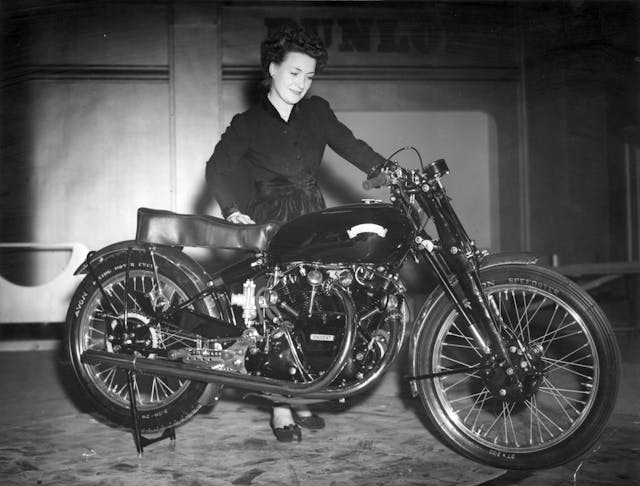
So. The Black Lightning. On one hand, we have that forward-think layout. On the other hand, there is that lightly prehistoric front suspension. Those two long vertical pieces on each side of the wheel—the “girders”—are tied to each other by two horizontal links running forward from the tank. One shock lives behind each girder, angled to the rear.
Seen from the side, the girders and their links form a box. On a Vincent, a coil spring sits in that box, above the bottom link and between the girders. Remove the spring, the front suspension will collapse.

Those circles on the fork and its links, silver in the black, represent the pivot points.
If none of that makes sense, watch this.
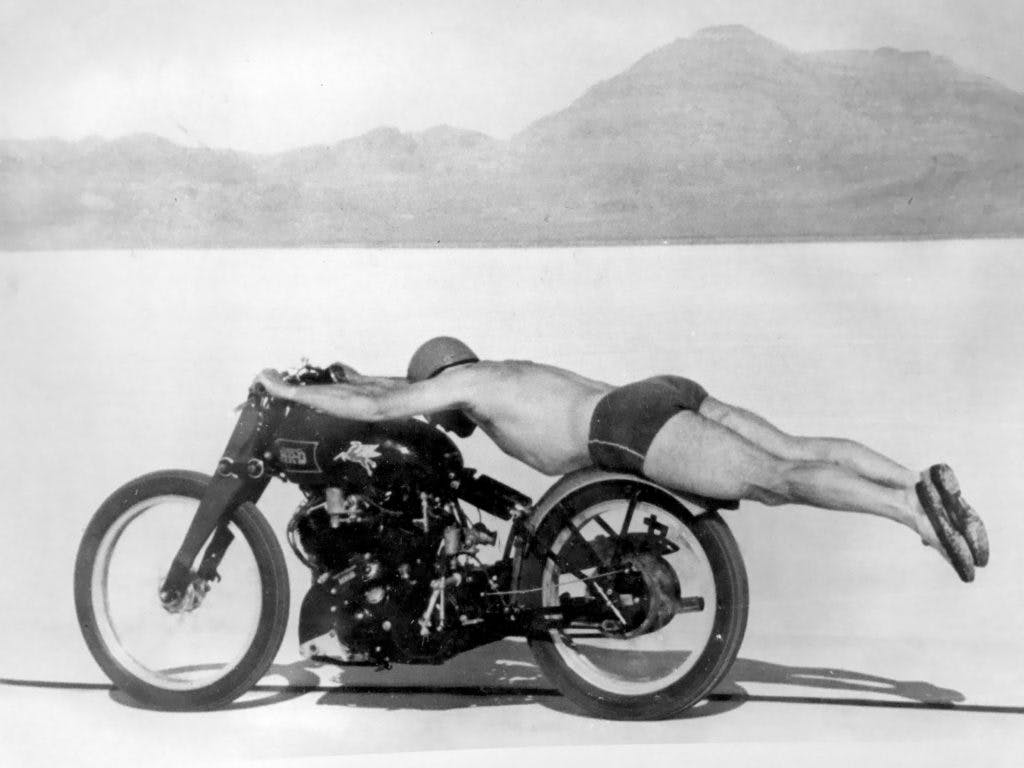 Back to the top photo. Again, that is Free, in 1948, same salt, same model of bike. This image has been called “the most famous picture in motorcycling.”
Back to the top photo. Again, that is Free, in 1948, same salt, same model of bike. This image has been called “the most famous picture in motorcycling.”
Look at the salt stuck to the bottom of his shoes! Look at the helmet! The helmet is comical! The man is virtually naked, riding across what might as well be the world’s largest piece of sandpaper, and he is so concerned about safety, he is wearing a helmet.

As a young man, Free worked in motorcycle retail and began racing. In World War II, he was stationed in Utah, with the Army Air Force, and he saw Bonneville for the first time. After the war, he went back to competition. He grew familiar with Vincents and developed a relationship with their maker.
Philip Vincent grew up in a wealthy family of cattle farmers. In 1925, while in school at this place, he began building a bike of his own design. Three years later, he decided to make motorcycles for the masses. He bought a defunct English bikemaker, HRD.
British motorcycles of the time were often designed around bought-in parts. A marque’s engineering head would call an engine company for engines, a gearbox company for gearboxes, and so on. Vincent did this at first. His bikes were used hard, however, and they broke. In the early 1930s, he hired a man named Philip Irving as chief engineer. The two men grew tired of all the breakage. In 1934, in a moment fit for the movies, they entered three factory race bikes in the Isle of Man TT. Mechanical trouble downed all three.
Screw it, Vincent said: He and Irving would make their own engines from scratch.
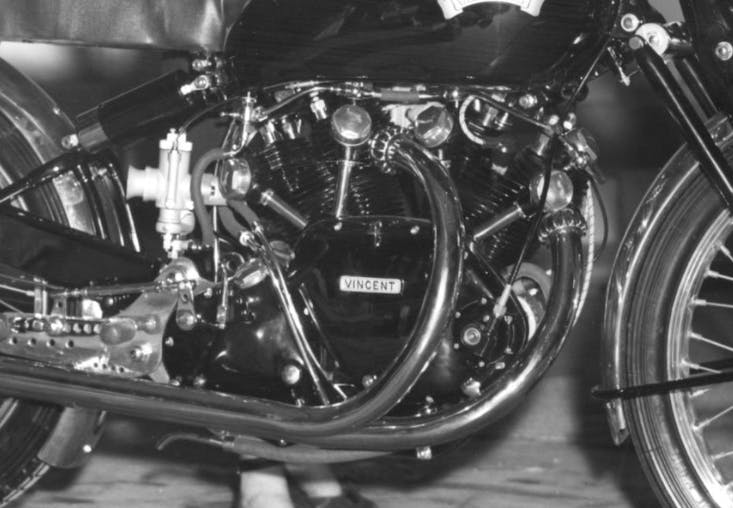
The bikes were called Vincent-HRDs. Later, they would simply be Vincents. At first, they wore relatively durable single-cylinders. One day in 1936, however, Irving was working in his office. Two engineering drawings of a company single, he noticed, had been casually laid over each other on a table. Their shapes made a V.
Ah, he thought: a V-twin. And so that engine soon appeared, in a new, 1.0-liter Vincent, the 45-horse Rapide.
War paused everything. When Vincent production restarted in 1946, the Rapide had been improved. The engine and gearbox, formerly separate components, now shared a single, stiff case. Critically, the bike had lost most of its frame—that stressed-member idea—and 1.5 inches of wheelbase. Ads called it “little big twin”: the size of a 500-cc bike, the power of a full liter.
There was a hot-rod model, because of course there was. It made such a dent in humanity that good examples are now worth six figures. The 55-hp Vincent Black Shadow, launched in 1948, received more compression, polished rods, larger carbs, and so on. The engine cases, once bare aluminum, were now black enamel. Top speed went from 110 mph to more than 125. It was the fastest production bike on earth.

At this point in history, the world’s popular motorcycles essentially fit into two groups. American bikes were durable but generally heavy, built on cubic inches. European bikes were mostly lighter and more nimble; the English in particular placed a priority on healthy power from small engines. The Black Shadow was essentially the two ideas crashed together.
My favorite part of this lore: In 1948, many motorcycles could not reach 100 mph, the myth-laden “ton.” The Rapide’s speedometer stopped at 120. The Shadow’s main clock was this five-inch, 150-mph Smiths pie plate used on no other bike. The 100-mph mark wasn’t even labeled. It wasn’t a destination.

The Black Shadow gained a reputation. People saw it as a mystical idea, a figment. It was in reality a locomotive, Harley grunt plus good handling and brakes, with virtually unbelievable numbers. Add to this the traditional British motorcycle aesthetic—deep plating, artful castings—and people went nuts. Californians in particular.
Back to Rollie Free. In the late 1940s, he is friendly with a West-Coast racing enthusiast named John Edgar. He convinces Edgar that a tweaked Black Shadow would demolish the American motorcycle speed record, then 136 mph. Free writes the Vincent factory and proposes another hot rod. Vincent the man is interested. Irving engineers and builds the bike in just ten weeks. Edgar pays for it. It is stripped and massaged and runs on methanol. George Brown, in Vincent’s comp department, hurries to a nearby airfield for testing. He comes back and tells Vincent that he saw 143 mph, engine still pulling, before he ran out of runway.

The machine is shipped to Los Angeles. Free takes it to Bonneville. Mobil kicks in funding. The world does not get excited, because almost no one is told. On the salt, stretched across the bike’s rear, Free lays flat, to minimize drag. He wears motorcycle leathers.
An early run produces 147 mph. This is deemed too slow. Nonplussed, our man sets those leathers aside.
Remember: The previous record was just 136 mph.
What followed beggars belief. If photographs did not exist, the specifics would have long ago been chalked up to hype and tall tale. But our man . . . our 47-year-old man . . . that barrel-chested and balding American . . . my dude in the fantastic leather boots . . .
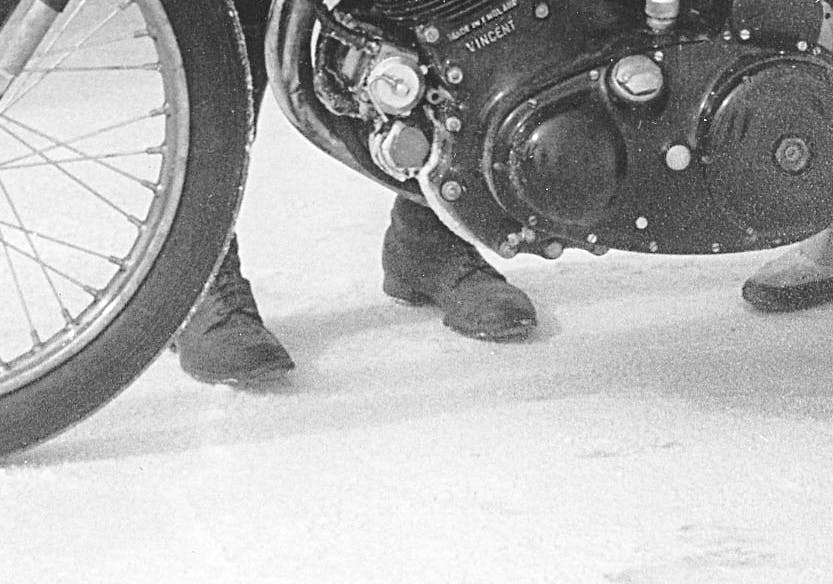
Well, this dad-bod bad-ass simply got back on the bike. In a bathing suit.
Clarification: There was also a pair of sneakers.
One hundred and fifty miles per mother-of-God hour on that seatless motorcycle, mostly naked, at a time when ordinary citizens did not, could not, easily go that fast or faster by simply walking into the nearest Honda dealer and putting a CBR on some overheated credit card. Free had laid on a bike in that manner before, but this was different. He reset that land-speed record. Shortly after, Vincent made Free’s hot-rod spec a production model, the Black Lightning. The new fastest in the world, replacing the other fastest, the thing from which it was built.

Several weeks ago, I walked into my kitchen and saw a glass of orange juice I had left out, overnight, by accident. I grabbed the glass out of habit, raising it to my mouth, then paused.
“Probably shouldn’t drink that,” I thought. “Bad odds.”
Modernity has made us all weenies.
We all choose to take risks. A select few of those risks are compelling enough to be remembered after we are gone. They stand apart from their background, dense with story, like that vast pan of salt. The salt is shrinking, but it will still outlive us all. The choices, on the other hand, are only around while we have time to make them.
It is enough, I think, to simply be reminded that we should, to coin a phrase, occasionally just drink the juice.
Have a good day, guys!
—Sam
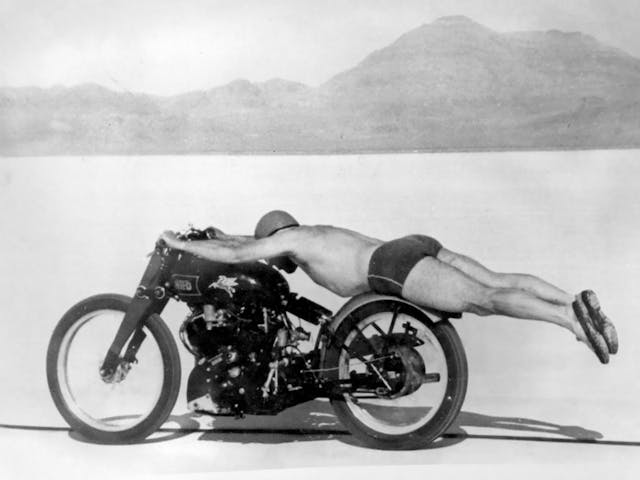


The helmet was for aerodynamics, obviously…
Great story – thanks, Sam. I knew about Vincents, but this really rounded out a lot of things I didn’t know. I’ve seen the photo before, but never knew the full story. I live fairly close to Bonneville, and visit when I can – it’s a trip that any gearhead should make at least once (or more than once if, as has been happening more and more, the running has been cancelled).
I’m pretty much a dinosaur, and I quite often need to be held back from saying “hold my beer”. My father was a big influence on me, and he was a guy who – well, one story might help explain: My dad was born in 1910. He lived through the Great Depression and was a POW in WWII (as a civilian). He broke his back 9 days before I was born and was a paraplegic. Not much fazed him. He once showed me how a suspension bridge could be made to shake by throwing down his crutches, clinging to a cable, and going hand-over-hand out over the edge of the Snake River Canyon (near where Evel jumped), then bouncing up and down while suspended in air. Since he propelled himself with his hands in a wheelchair, he was confident in his arm strength, but to my 10-year-old self, if was shocking to see. Then he calmly swung a 180, and came back to solid ground, asking me to hand him the crutches. Nothing scared him.
So when I see people like Rollie Free in old photos, I totally agree that a lot of modern men are indeed weenies, and I try to channel a bit of my dad’s bravado and “just do it”. There ain’t no way I’m going to ride a motorcycle, naked, at 150 MPH, nor hang out over an 1/8-mile deep chasm, but I’ve no problem with warm OJ! 😄
Thank you for this. I’d seen the cover photo a thousand times…it was the wallpaper image already on the computer when I started a new job a few years ago…but I never knew anything else about it.
The trailer behind the Mercury in that one photo ? That was for carrying Free’s balls.
That top photo, and one taken at Pomona with Willie Borsch sideways at full throttle, his Fuel Altered’s driven tires peeling off the rims while up in smoke, are favorites of mine. Feeling tentative ? Consult those photos.
AN ABSOLUTLY GREAT STORY…THE LIKES OF WHICH WE WILL NOT SEE AGAIN I BET…PLUS VINCENT IS ONE COOL SCOOTER!
The first and second pictures in the article show two different models. The first picture, at speed, is a “B” series frame, with Brampton forks made of thin-walled tubing. In the picture, the tubing is covered with black tape for streamlining. “B” series models carried the “HRD” name on both the tank and on the engine. The second picture, apparently from a later trip to Bonneville, shows a “C” series frame with “Girdraulic” front forks. The Girdraulic forks were an alloy forging that was much stiffer and stronger than the Brampton design. C Series frames went into production around the time Vincent changed the name from “HRD” to “Vincent” – the earlier picture shows “HRD” and the later picture shows “Vincent” on both the tank and on the engine.
This comment is not meant to diminish the author’s point – doing 150 MPH on a motorcycle with comparatively flimsy Brampton forks is not for the faint of heart. The stuff legends are made of…
Glad to know the story behind that famous photo.
I guess we can all be glad he didn’t decide to do another run and try for 151 mph. 😉
Richard Thompsons “1952 Vincent Black Lightning” is one of my all time favorite songs. Great lyrics, great guitar playing, great voice, great motorcycle.
Let’s not forget Marty Dickerson also going to to the salt. The last time I saw Rollies bike Wes in Marty’s garage , in Thousand Oaks . It was offered to me for 2000$ in 1968 .😣
I’m 1969 I found a shadow engine 2 front heads Lightning cans an with Bob Fleconstein a long time Edelbrock. Employee , bored an stoked it from 60 to 90 inches . Went to track master frames an made a frame out of chrome moly ,a swing arm , an Cherry Anny forks. It weighd 225 lbs . Maybe I can find a picture . I sold it about 6 yrs ago .
I love the Rolly Free photo and the Vincent engine has to be one of the most elegant ever manufactured…I could stare at it for hours. One thing always amazes me about that iconic photo- how did the rear fender not collapse onto the rear tire under Rolly’s weight? I know he wasn’t a real hefty guy but still, some quality fender struts there!!
How do you guys get any work done??🙂
Love it!!
Reminds me of Mike Rowe (Dirty Jobs) point of “Safety Third” — basically that putting Safety First completely neuters any effort to push beyond. This was a calculated risk, but HE was more confident in his capabilities then than many/most people are today!
It’s the superman shot.
One detail not mentioned. Notice that line painted on the salt? Notice that’s what he’s looking at? That is his means of staying in a straight line. As if riding a motorcycle at 150 mph in a swim suit isn’t enough of a challenge, he’s not even looking where’s he’s going!
Other features different in the Series B and Series C pictures: the earlier bike had the front stand (two side stands, one on each side) and no rear stand, and footrests in the regular position, while the later bike has just a rear stand (with nowhere to secure it in the up position) and rearsets. Also, much as I love Richard Thompson’s song, no Vincent ’52 had a key.
I owned a ’51 Rapide in Connecticut in the 1960s. It had a racing magneto with a manual advance-retard, and I just left it at full advance as a crude anti-theft device. I heard that the Vinvent was illegal in Connecticut because it had no frame, so I just rode it on the British plates I bought it with …